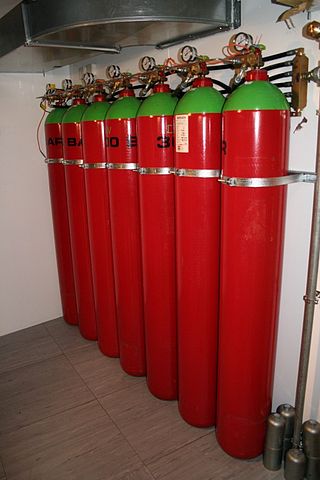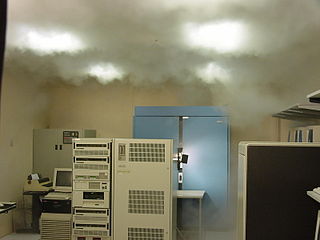Related Research Articles

A diesel multiple unit or DMU is a multiple-unit train powered by on-board diesel engines. A DMU requires no separate locomotive, as the engines are incorporated into one or more of the carriages. Diesel-powered single-unit railcars are also generally classed as DMUs. Diesel-powered units may be further classified by their transmission type: diesel–mechanical DMMU, diesel–hydraulic DHMU, or diesel–electric DEMU.

Bromochlorodifluoromethane (BCF), also referred to by the code numbers Halon 1211 and Freon 12B1, is a haloalkane with the chemical formula CF2ClBr. It is used for fire suppression, especially for expensive equipment or items that could be damaged by the residue from other types of extinguishers. It is stored as a liquid under pressure and vaporizes when discharged to suppress fires. The use of halons, including Halon 1211, has decreased over time due to their adverse impact on the ozone layer. Alternatives have been developed to mitigate environmental concerns while still providing effective fire suppression capabilities.
Bromotrifluoromethane, commonly known as Halon 1301, R13B1, Halon 13B1 or BTM, is an organic halide with the chemical formula CBrF3. It is used for gaseous fire suppression as a far less toxic alternative to bromochloromethane.
United Technologies Corporation (UTC) was an American multinational conglomerate headquartered in Farmington, Connecticut. It researched, developed, and manufactured products in numerous areas, including aircraft engines, aerospace systems, HVAC, elevators and escalators, fire and security, building automation, and industrial products, among others. UTC was also a large military contractor, getting about 10% of its revenue from the U.S. government. Gregory J. Hayes was the CEO and chairman.

Saudia Flight 163 was a scheduled Saudia passenger flight departing from Quaid-E-Azam Airport in Karachi, Pakistan, bound for Kandara Airport in Jeddah, Saudi Arabia, via Riyadh International Airport in Riyadh, Saudi Arabia, that caught fire after takeoff from Riyadh International Airport on 19 August 1980. Although the Lockheed L-1011-200 TriStar made a successful emergency landing at Riyadh, the flight crew failed to perform an emergency evacuation of the airplane, leading to the deaths of all 287 passengers and 14 crew on board the aircraft from smoke inhalation.
This is a glossary of firefighting equipment.

UTC Climate, Controls & Security was a global provider of building technologies offering fire safety, security, building automation, heating, ventilating, air-conditioning, and refrigeration systems and services. A wholly owned subsidiary of United Technologies Corporation, UTC Climate, Controls & Security was a $16.7 billion company with 55,000 employees serving customers in more than 180 countries.

Gaseous fire suppression, also called clean agent fire suppression, is a term to describe the use of inert gases and chemical agents to extinguish a fire. These agents are governed by the National Fire Protection Association (NFPA) Standard for Clean Agent Fire Extinguishing Systems – NFPA 2001 in the US, with different standards and regulations elsewhere. The system typically consists of the agent, agent storage containers, agent release valves, fire detectors, fire detection system, agent delivery piping, and agent dispersion nozzles.
Active fire protection (AFP) is an integral part of fire protection. AFP is characterized by items and/or systems, which require a certain amount of motion and response in order to work, contrary to passive fire protection.
Kidde is a brand subsidiary of Carrier Global that manufactures and distributes fire detection and suppression equipment, as well as smoke and CO alarm units. Kidde is one of America's largest manufacturer of smoke alarms and fire safety products. Kidde is headquartered in Mebane, NC.
A fire class is a system of categorizing fire with regard to the type of material and fuel for combustion. Class letters are often assigned to the different types of fire, but these differ between territories; there are separate standards for the United States, Europe, and Australia. The fire class is used to determine the types of extinguishing agents that can be used for that category.
The Centre for Fire, Explosive and Environment Safety (CFEES) is an Indian defence laboratory of the Defence Research and Development Organisation (DRDO). Located in Timarpur, Delhi, its main function is the development of technologies and products in the area of explosive, fire and environmental safety. CFEES is organised under the Armaments Directorate of DRDO. The present director of CFEES is Arvind Kumar
PhostrEx is a fire suppression agent developed for use in aviation applications to replace halon, a greenhouse gas (GHG). It was developed by Eclipse Aviation for use aboard their Eclipse 500 very light jets as an engine fire suppression system, and is now being marketed to other aviation manufacturers.

A fire extinguisher is a handheld active fire protection device usually filled with a dry or wet chemical used to extinguish or control small fires, often in emergencies. It is not intended for use on an out-of-control fire, such as one which has reached the ceiling, endangers the user, or otherwise requires the equipment, personnel, resources or expertise of a fire brigade. Typically, a fire extinguisher consists of a hand-held cylindrical pressure vessel containing an agent that can be discharged to extinguish a fire. Fire extinguishers manufactured with non-cylindrical pressure vessels also exist but are less common.

Automatic fire suppression systems control and extinguish fires without human intervention. Examples of automatic systems include fire sprinkler system, gaseous fire suppression, and condensed aerosol fire suppression. When fires are extinguished in the early stages loss of life is minimal since 93% of all fire-related deaths occur once the fire has progressed beyond the early stages.

Ansul is a corporation headquartered in Marinette, Wisconsin that manufactures fire suppression systems, extinguishers, and administers fire training. Ansul's initial activities included production of cattle feed, refrigerants and selected specialty chemicals. The name Ansul comes from ANhydrous SULfur dioxide (SO2), which was sold to die works and fruit preservers, and later as a refrigerant. Production of fire suppression chemicals began in 1934. Virginia Chemicals, Inc. (now part of Celanese Corporation) acquired the Refrigeration and Air Conditioning Products Division of The Ansul Company in 1967, and by 1983 Ansul had discontinued all other production at the facility in Marinette. The US government is a major customer for Ansul.

The Pyrene Company Limited from their beginning in 1914, until 1971 when they became Chubb Fire Security Limited, were among the world's leaders in the manufacture of fire fighting equipment. The name Pyrene was epitomised by their famous 'pump' extinguisher which was installed on public transport, commercial and private vehicles throughout the western world.

A ground combat vehicle, also known as a land assault vehicle or simply a combat vehicle or an assault vehicle, is a land-based military vehicle intended to be used for combat operations. They differ from non-combat military vehicles such as trucks in that they are designed for use in active combat zones, to be used in mechanized warfare and mobile infantry roles.

Condensed aerosol fire suppression is a particle-based method of fire extinction. It is similar to but not identical to dry chemical fire extinction methods, using an innovative pyrogenic, condensed aerosol fire suppressant. It is a highly effective fire suppression method for class A, B, C, E and F. Some aerosol-generating compounds produce a corrosive by-product that may damage electronic equipment, although later generations lower the effect.
Hamilton Sundstrand was an American globally active corporation that manufactured and supported aerospace and industrial products for worldwide markets. A subsidiary of United Technologies Corporation, it was headquartered in Windsor Locks, Connecticut. The company was formed from the merger of Hamilton Standard and Sundstrand Corporation in 1999. In 2012, Hamilton Sundstrand was merged with Goodrich Corporation to form UTC Aerospace Systems. In 2018, UTC Aerospace Systems and Rockwell Collins combined to form Collins Aerospace.
References
- ↑ "Archived copy". Archived from the original on 25 June 2016. Retrieved 24 May 2016.
{{cite web}}: CS1 maint: archived copy as title (link) - ↑ Flight International 1954
- ↑ John O'Brien, Technical Manager, Kidde Graviner
- Times, 31 August 1962, page 22
- Times, 30 September 1966, page 15